Working horses - introduction
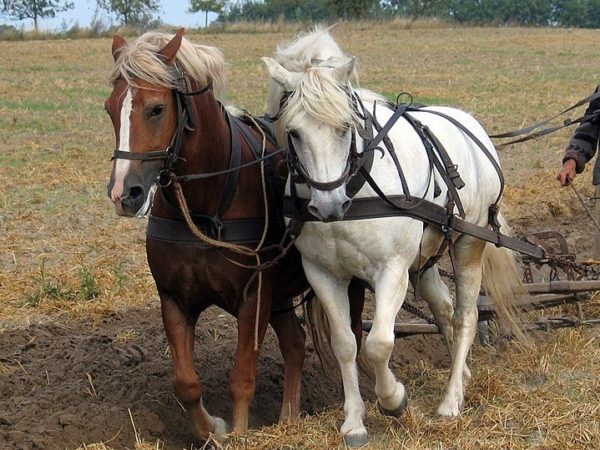
“Of all the animals humans have domesticated, the horse is the most important to our history.” – Elton Gallegly
Contents
What are working horses?
Working horses are usually heavy (or draught) horses used for transport, working agricultural land, and forestry work. On farms horses can be used for anything from land preparation to harvesting, including ploughing, sowing and haymaking. The energy of a working horse can be used directly, e.g. ploughing or pulling a cart, or indirectly, where the horse pulls equipment which turns, transferring energy to revolving parts via a system of gears and cogs, e.g. hayturners, muckspreaders, elevators or binders.

The muscular Ardennes horse, from which all heavy horse breeds originate.
Horses are thought to have been domesticated as long ago as 4000 BCE and have been used for hunting, transport, warfare and agriculture throughout human history. Horses are extremely social animals, naturally living in large herds with a dominance hierarchy, and can often form strong bonds with humans, or other animals, as well as their herd mates.
Most communication between individuals in the herd is through body language, this expressiveness may be part of what makes the horse so attractive. Their responsiveness to body language and sensitivity to dominance, along with their curiosity, is what makes them easy to train. Horses are evolved to flee and have a strong flight response, in breeds used for working, this response has been dulled by selective breeding to produce more docile animals.

A Shire horse pulling a harrow. The Shire is the largest British breed of draught horse (pic: Martin Pettitt, CC BY 2.0).
Although working horses are traditionally very large, heavily built, breeds such as the Shire, horses and ponies of all sizes have been used over the centuries. Working horses tend to be stockily built, with confirmation adapted for pulling and carrying loads, with short, broad backs and powerful hind quarters. They also need to be calm, docile and easy to work with.
British breeds of heavy horse include the Shire, Clydesdale and Suffolk Punch. Other countries have their own breeds, including some smaller breeds such as the Austrian Haflinger. In the UK there are some smaller traditional working horse breeds, generally referred to as ‘Cobs’, such as the Fell or the Dales. Cobs are not as powerful as Shires or the other bigger breeds, but they are cheaper to keep. In fact, most of the native pony breeds of the UK were originally developed to work and can still be used in this way, even the tiny Shetland.

A Shetland pony in harness. Shetlands are stronger, relative to their body weight, than even Shire horses (pic: Brian Robert Marshall, CC BY-SA 2.0).
What are the benefits of working horses?
Horses have a much lower impact on the land than heavy machinery, causing less, and shorter term, damage to soil structure and flora and fauna. They can therefore be used in sensitive sites such as ancient woodlands, ancient meadows and archaeological sites. This lower impact also means horses can be used on boggy ground or early in the year when the land is too wet for heavy machinery. Additionally, the manoeuvreability of horses means they can be used on steeper and less open sites than tractors.
Horses are not fuelled by fossil fuels but by grass and other plants, much of which you may be able to grow yourself or obtain locally from sustainable sources. As a bonus they will provide you with excellent fertiliser, and could even be used to produce milk and meat. Breeding and training horses can also provide an additional income stream. Working with horses will keep you fitter than working with a tractor and if, like many people, you love being with horses your passion can become part of your sustainable lifestyle. Many people are fascinated by working horses, providing opportunities for demonstrations and training. This is another way to provide an income, or at least many new friends!

Logging with a horse (pic: Steffi Schaffler).
A hectare of grain can provide bioethanol to cultivate 10 hectares using a tractor. The same hectare can feed 2 horses that can also cultivate 10 hectares, but without the pollution or the embodied energy of machinery or factories, and they’ll provide manure to produce more grain (The Land, issue 2). Farmers prefer tractors because of speed – time is at a premium because of the need to earn money due to rising land prices and the power of large supermarkets to squeeze their incomes. Systemic economic and planning change is required if farmers (and the rest of us) can live and work at a slower pace, more in harmony with nature, without being bankrupted.

Making hay the old-fashioned way (pic: Mark Robinson, CC BY 2.0).
What can I do?
Working with horses is a way of life that can bring personal and environmental well-being. If you have never worked with horses find a way to spend some time with them. You could attend a course or volunteer through WWOOF on a farm with working horses, to find out if it is the life for you. Spending as much time with horses as you can before you take on horse yourself may make your life much easier later on; horses are very sensitive to body language, and even a docile working breed will take advantage of someone they sense is inexperienced. Using the correct body language can be taught, but comes most easily through experience. There is a huge amount of knowledge that has to be built up to look after and work horses; the help and advice of an experienced person, especially one who lives near by, is invaluable.

A pair of Haflinger horses pulling a mower.
Getting horses
Consider the space you have and the work you need your horse, or pony, to do. Larger breeds are more expensive to buy and keep than smaller ones, and it makes little sense to buy a Shire horse when a Highland pony could easily do the work. If possible, find someone who keeps the breed you think you might want, spend some time with them and see the sort of work their horses can manage. You need to keep at least 2 horses. If you only need one expensive working horse, your second horse could be a retired pony or a horse unsuitable for work for some reason, but otherwise healthy.
Talk to experienced horse owners about where to purchase horses. Also, look in your local papers, or in the classified section of Heavy Horse World. You’ll need an experienced person to go with you to look at a horse. You need to see them trot, and check their eyes, mouth etc. If you don’t have the background, there are lots of things that can go wrong. Spend some time handling the horse, see it at work, observe how it behaves around traffic and strangers. It makes sense to ensure your first horse is an experienced working horse – it will then teach you. If you are planning to take on a young horse and train it yourself it is important you have the help of an experienced person.

A Fell Pony. Originating in Cumbria these are one of the smaller, ‘cob’ size, traditional working horses (pic: Paul, CC BY-SA 2.0).
Grazing and shelter
For 2 horses you will need at least an acre of grazing, probably more to allow for some pasture rotation (see ‘health’ below). Fencing should be at least 4 feet 6 inches high and should not be sheep netting or barbed wire, both of which can result in injury for horses. Horses can be very hard on fences, often leaning over them to get grass or using them as scratching posts. If you can afford it, post and rail is a really good option, but it can be very expensive.
Most working horse breeds are hardy and can live out all year round, however they should always have a field shelter. Ideally your field shelter should have a partial fourth wall rather than being entirely open-fronted, to provide protection from the wind and rain in the worst weather. You need to have a space where your horse can be kept in if necessary. This might be a field shelter with a door, or it might be a separate stable.

Horse pulling a narrowboat on a British canal.
Feeding
Horses need a high percentage of their diet to be roughage; they should be given plenty grazing, supplemented by good quality hay or haylage especially in the winter. Giving a horse access to grazing or hay at all times is important for its mental as well as physical health. Depending how hard your horse is working, and its individual metabolism, constant access to good quality grass and hay may be all your horse needs, perhaps with a little sugar beet and alfalfa for extra energy in the winter. If your horse starts to lose condition in the winter then you may need to provide more concentrated feeds, this could be a mixture of grains and legumes such as peas, but should make up a small portion of your horses diet and be fed in small amounts (i.e. 2 or 3 times a day rather than all at once). Horses should always have access to clean drinking water and a mineral lick.

The Highland pony is a hardy pony native to Scotland. They can be a good choice for those looking for a small working animal (pic: Velvet, CC BY-SA 3.0).
Health
You will need a grooming kit for your horse. Opinions vary on how much a horse should be groomed, with some people thoroughly brushing their horses every day and others only rarely. At the very least you should ensure your horse’s legs and feet do not remain caked in mud and brush the sweat off them after they have been working. You should also clean out their hooves with a hoof pick. Grooming your horse is a chance to check them for any problems such as lice.
Most working horses in the UK are shod, especially if they will be walking on hard surfaces. Horses can also be given specialist shoes if they will be working on slippery ground. Shoes are around £100 a set, and need to be replaced every 6-8 weeks. You may want to investigate keeping your horses ‘barefoot’. this involves trimming the hoof in a way that mimics the natural wearing process (of a wild horse on varied terrain). Proponents of this method say it not only promotes a stronger, healthier hoof but prevents other leg and foot problems by preserving the horses natural movement. If you go down this route your horses feet will still need regular trimming and attention by an experienced person.

A pair of Suffolk Punch horses pulling a plough (pic: Amanda Slater, CC BY-SA 2.0).
Like most grazing animals horses suffer from intestinal parasites. Good pasture management can help prevent this becoming a problem. Research pasture rotation systems, where areas of grazing are rested for periods of time. Removing dung from the field also helps, though it can be time consuming task. It used to be recommended that horses be wormed every 12 weeks, however, it’s important not to treat your animals for worms more often than necessary, as this can lead to resistance to the medications. Consider conducting regular faecal egg counts to monitor the parasite levels in your horses and only treat when necessary. You can now easily buy kits to do this yourself, or you can send faecal samples to a lab who will do it for you.
Find a good vet who has experience with horses and check your horses over everyday. Learn to look out for signs of common problems such as laminitis and colic. There are a number of vaccinations recommended for horses, the most important protect against tetanus and equine influenza.

A young Clydesdale. this breed originated in Scotland, it is one of the larger draught horses, though tends not to be quite as tall as the Shire (pic: Kersti Nebelsiek, CC BY-SA 3.0).
Working with horses
Training horses is a huge subject, and there are many different approaches and methods. If you plan to do this make sue you have the help of an experienced person who is generous with their time, and expect it to take many moths to train a horse to reliably work in harness. Assuming your new horse is trained, first get used to handling it, make sure the harness fits, and is comfortable, and that you can give basic commands to walk, halt and turn. Once this is going smoothly you can start to think about putting implements or machinery to them, ideally starting with a job with which the horse is familiar. Working with horses can be dangerous, but experience will help you remove the danger element. You can’t remove the risk completely though – you’ll need to be fit and strong yourself, and have lots of common sense. The secret is to build layers of experience over time, and not try to do too much in one go. Always seek the help of someone more experienced if you are unsure.
Training a young Irish Cob to harness using long-reining (one in an excellent series of videos on training).
A basic harness can be very simple, depending on the job. For horse logging you’ll need a collar, a simple pulling harness, chains and spreader bar which will come to around £350. This can rise to £1200-1500 for kit for more complicated jobs, or for pairs of horses. You can make your own harnesses if you have leather-working skills.
If you’re doing work off-site for other people, you’ll need insurance and risk assessments. You’ll also need safety gear such as steel-toecap boots and a hard hat, and if you’re a novice, you’ll need someone working with you. For horse logging, you’ll need chainsaw certification and a felling licence from the Forestry Commission – even on your own land.
Specialist(s)
Thanks to Ben May of Forest Crafts for information, and Ralf Roletschek for main image.
The specialist(s) below will respond to queries on this topic. Please comment in the box at the bottom of the page.
 Ellie and Mike Paddock run Hitch In Farm Working Horses in West Devon. They met in 2015 whilst working in horse logging in Hereford. Mike was the British Horse Loggers first apprentice before becoming the head horseman to the Prince of Wales. Ellie is a conservation biologist by training who has been a keen carriage driver since the age of 14.
Ellie and Mike Paddock run Hitch In Farm Working Horses in West Devon. They met in 2015 whilst working in horse logging in Hereford. Mike was the British Horse Loggers first apprentice before becoming the head horseman to the Prince of Wales. Ellie is a conservation biologist by training who has been a keen carriage driver since the age of 14.


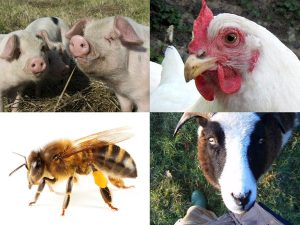
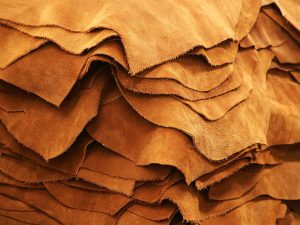
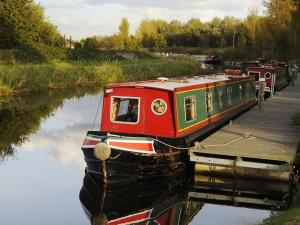
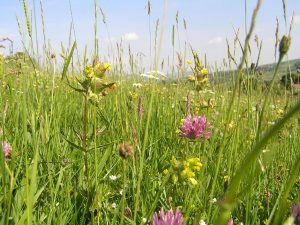
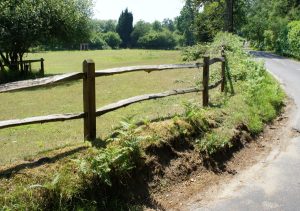
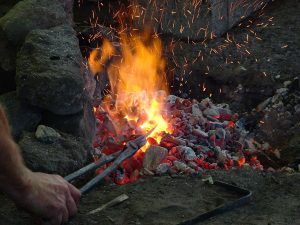
4 Comments
I am doing some research into the use of horses on the Harnham Water Meadows in particular and in South Wiltshire in general. I am a Trustee of the Harnham Water Meadows and we have been asked to head up a project funded by Heritage Lottery and Wiltshire Council to promote, record and conserve rural crafts of South Wiltshire. Having been long associated with horses and am old enough to help the ploughman and his two Clydesdale horses plough fields where I lived, I consider that the use of horses in agriculture a Rural Craft!
Water meadows work by a pattern of manmade channels. in around the 1860’s Lord Pembroke created ‘hay cart bridges’ so that he could get the extra hay crops from the meadows in to the City of Salisbury to sell. What weight/ type of horse would he have used? I have found two very heavy old shoes, one measuring 15cm x 17cm length the other more rounded 15cm x 14cm., my memory of the Clydesdale’s is ‘meat plates!
best wishes
Jan Fitzjohn
Hi Jan, it most probably would have been shires, but of the traditional farm type, recently bred from a combination of the English Black horse and imported Brabant horses. They would have averaged about 16hh but would be extremely chunky, about 800-900kg. Hope that helps. Ellie
Hi – We’ve got a 3 acre field in the Lenches, Worcestershire and would love to use heavy horses to cut the field for haylage. Would it be possible to put me in touch with local heavy horse owners? Or, if anyone reading this would like to contact me about this please do so! THe bales cane be taken away to feed the horses. Thanks
Josephine – have a look at ‘courses’ and ‘products & services’ under resources – top right. That’s how we’d put you in touch with people! And, as you say, people reading this might be able to help. Good luck!